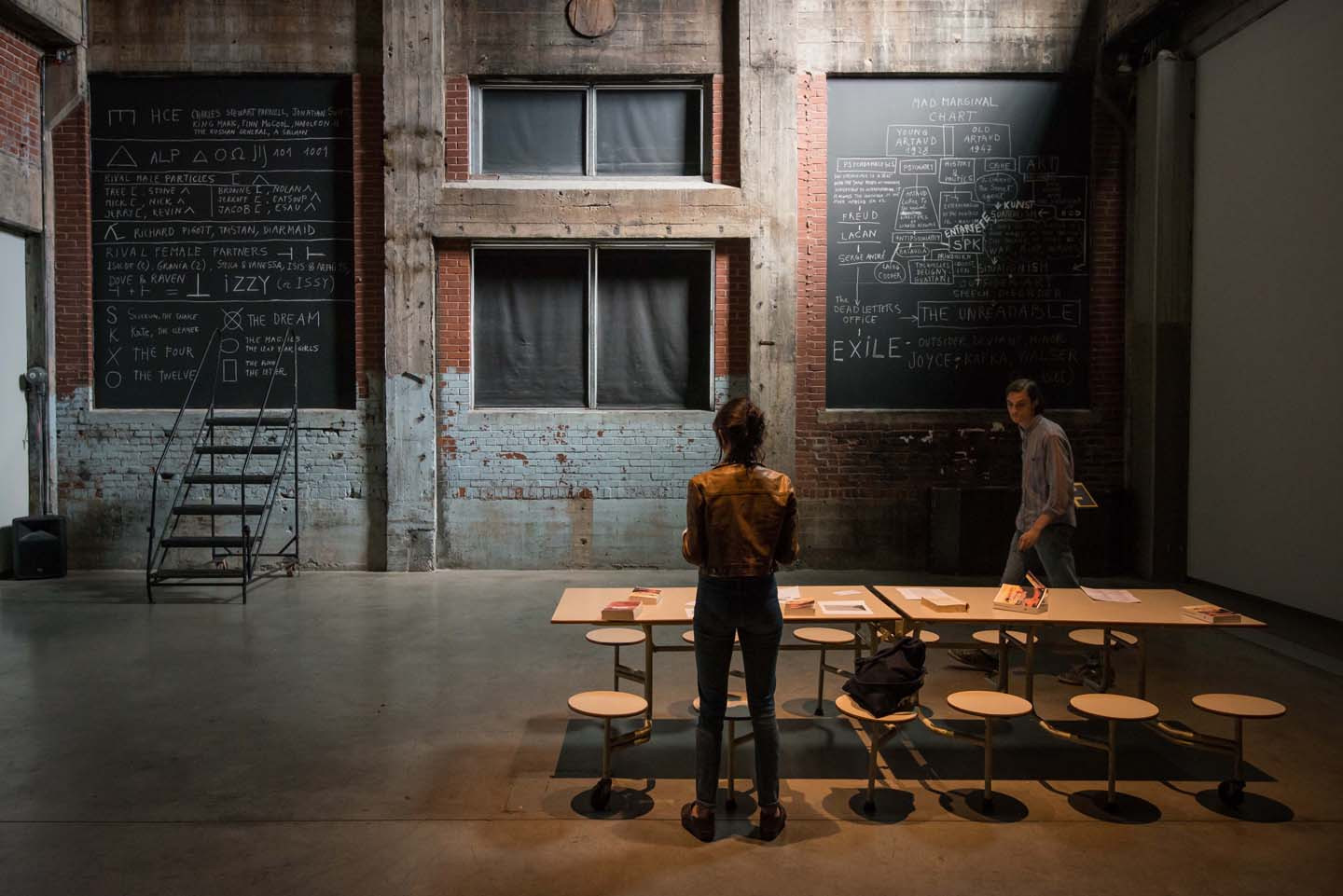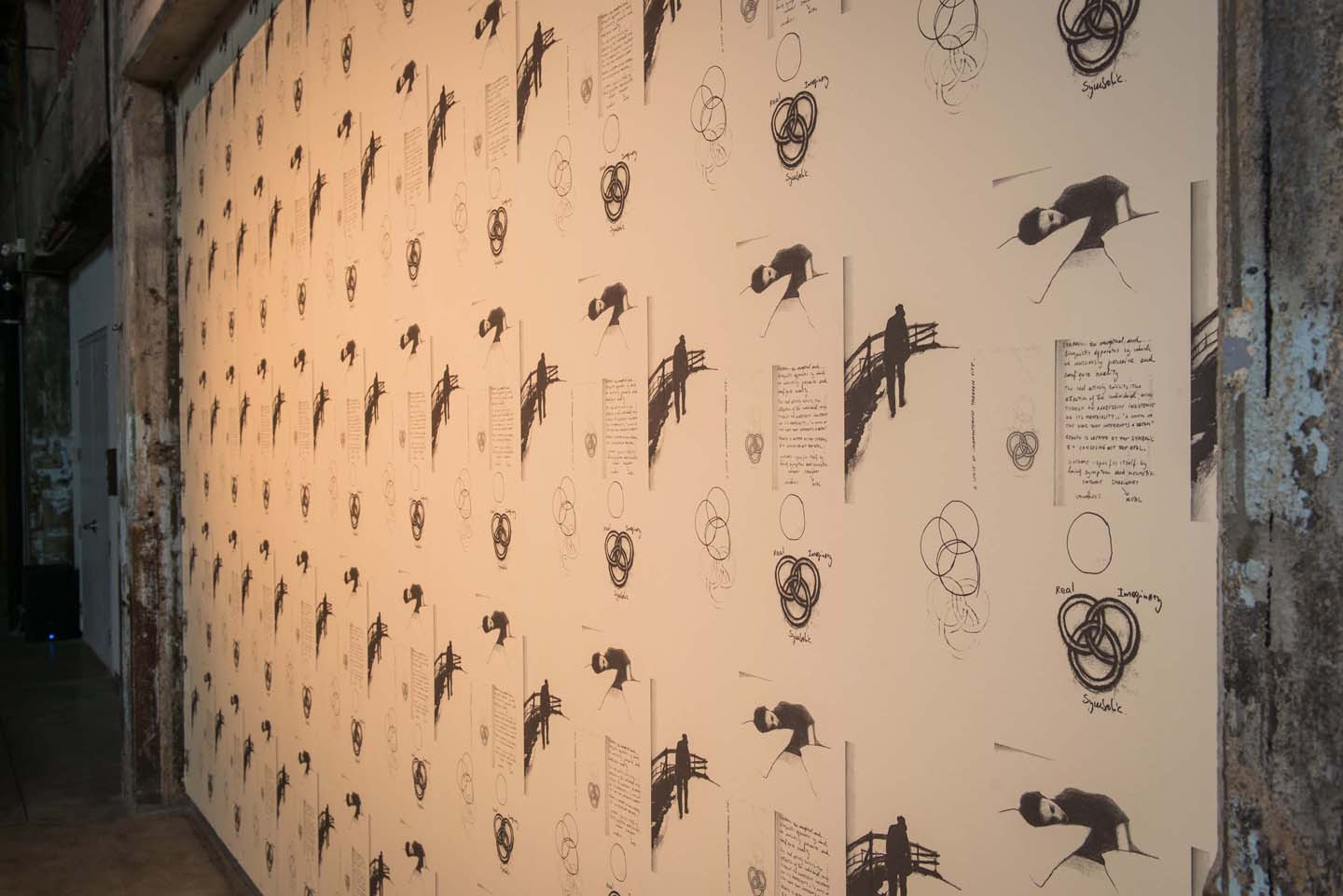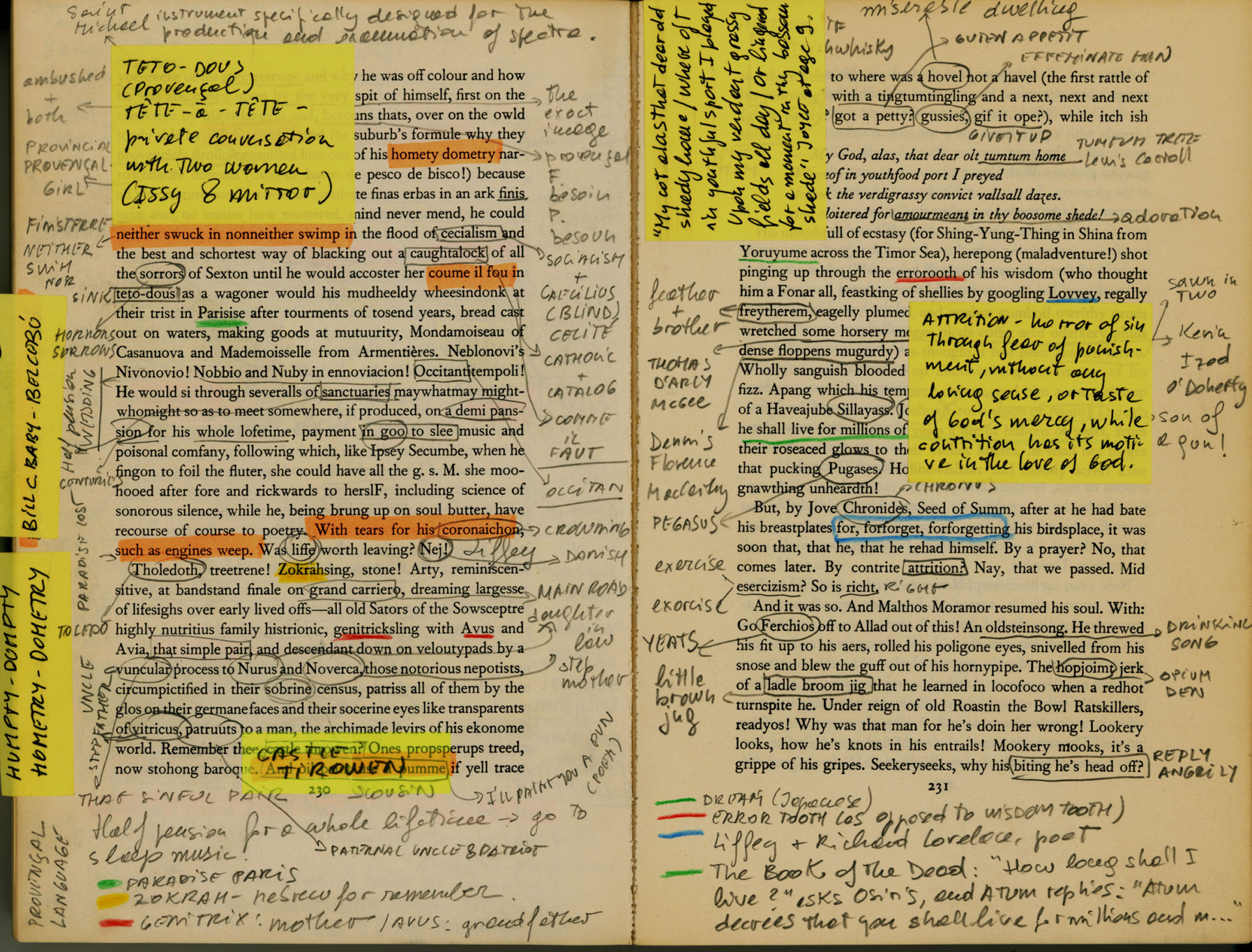






The exhibition "Of Crimes and Dreams" unfolds on the backdrop of a series of group conversations in the spring of 2013 at the Montperrin psychiatric hospital in Aix-en-Provence (within the frame of Ateliers de l'EuroMéditerranée - Marseille-Provence 2013, in partnership with 3 bis f - lieu d'arts contemporains), where Dora García had people read James Joyce’s Finnegans Wake and Félix Guattari’s 65 rêves de Franz Kafka, as a pretext for talking about what is real and unreal before the camera. The film Désordre (2013), an offshoot of this project, is shown, along with Hôtel Wolfers (2007) and The Joycean Society (2013), the previous films it echoes. This closes the circle traced since Hôtel Wolfers in which Beckett, Kafka, Joyce, Walser wander as in a dream, in their capacity as models of the “minor literature” theorized by Deleuze. J. Lacan Wallpaper (2013) covers one of the walls to mark the blindspots of inner space, as Lacan’s hieroglyphs for the unconscious bloom like discreet flowers on its partitions. The gallery’s windows are likewise covered with signs referring to ideas connected to everything that goes on in this peculiar universe (Mad Marginal Charts, 2014). Thus, crimes and dreams go side by side and haunt us from all sides, revealing the complexity and richness of the imagination.
The film Hôtel Wolfers (2007) echoes Samuel Beckett’s film, entitled Film, conceived and produced in 1965. In her film, García questions the viewer’s perspective, associated to that of a camera filming the walls of an exceptional villa, designed by architect Henry van de Velde, in 1929. Filmed in black and white, the camera pans the walls, as Buster Keaton does in Beckett’s film, tracing movements that resemble a dead-end chase. The camera is viewed as threatening, intrusive, even criminal, and possibly identifies as much with the viewer as with the film’s author. The viewer and author become confused in the last scene. An English voice-over provides a commentary on Beckett’s film, in reality without sound. This re-writing by García is characteristic of her research into deciphering language, images and words.
The Joycean Society (2013), filmed in colour this time, evokes a group reading of Finnegans Wake, typical of those carried out in Zurich society over the past thirty years. One word is deciphered at a time, and often group readings stop for the evening after only having read one or two pages. The polyphony of voices and polysemy of words imbue Joyce’s complex and difficult final work, this “monumental” piece of literature, with longevity. Seen in a new light here, the overwhelming Finnegans Wake text is at the core of a burstingly joyous performance in the daily realities of these passionate and tireless readers, though they are not specialists.
Shortly after filming the passionate Joyce-ingrained group, Dora Garía was invited to complete a residency in Aix-en-Provence, and chose to work with the Montperrin psychiatric hospital. She asked the group in attendance at a workshop to read Finnegans Wake and 65 Rêves de Franz Kafka, by Félix Guattari, and filmed the ensuing discussions. The atmosphere is just as joyous, as regulars open up about the unusal minglings between their readings and their dreams, between the events of their days and nights, simple pleasures and fears all mixed together. Here we see García’s interest in the world of emotions and marginality, and in the constant tracking of the realities of the “other,” which are sometimes ignored, hidden or repressed.
The viewer will notice that part of the wall space in the exhibition is covered with wallpaper. It’s Jacques Lacan Wallpaper (2014), reminiscent of Robert Gober’s work and of The Yellow Wallpaper (1892), by Charlotte Perkins Gilman. The wallpaper takes on the form of graphite drawings taken from García’s sketchbook. For instance, Robert Walser is depicted walking in the snow, along with other elements that inhabit her world of reflection, such as Jacques Lacan’s Seminar XXIII on “Le Sinthome”, referencing Joyce’s work. Ideas and references surface, the wallpaper serving as a backdrop for questioning motifs, formats, the unconscious as the language of the “other,” and as a backdrop for hallucinations.
In this context, the work Mad Marginal Charts appears covering the windows of the space. Initially developed at the request of French critic Guillaume Désanges, they serve to organize the numerous references inhabiting Dora García’s world, the sources of her Mad Marginal project series. Since 2009, the series has taken on various forms, while always remaining connected to the central idea that marginality is an artistic position. Her explorations have intersected with those of Artaud, R.D. Laing, Franco Basaglia, Robert Walser, James Joyce, Italo Svevo, Fernand Deligny, SPK, Entartete Kunst, Dadaism, Surrealism, Outsider Art, anti-psychiatry, deinstitutionalization, anti-institutionalization, radicalism, armed struggle, Bartlebyism, institutional critique, psychoanalysis, and deviant art and literature.
As a complementary element, the exhibition welcomes groups of readers-decipherers to collectively comment on Finnegans Wake.
Chantal Pontbriand
In collaboration with ACCIÓN CULTURAL ESPAÑOLA, AC/E
![]()


Chantal Pontbriand
Chantal Pontbriand is a contemporary art curator and critic. She was a founder of PARACHUTE contemporary art magazine in 1975 and acted as publisher/editor until 2007, publishing 125 issues. Her work is based on the exploration of questions of globalization and artistic heterogeneity. She has curated numerous international contemporary art events: exhibitions, international festivals and international conferences, mainly in photography, video, performance, dance and multimedia installation. After curating several major performance events and festivals, she co-founded the FIND (Festival International de Nouvelle Danse), in Montreal and was president and director from 1982 to 2003. She was appointed Head of Exhibition Research and Development at Tate Modern in London in 2010 and more recently founded PONTBRIAND W.O.R.K.S. [We_Others and Myself_Research_ Knowledge_Systems]. Since 2012, she is Associate Professor at the Sorbonne-Paris IV, in curatorial studies. In 2013, she received the Governor General of Canada Award for an Outstanding Contribution in the Visual and Media Arts, and in 2014, Concordia University, Montreal, will be offering her an Honorary Doctorate. Her most recent publication is The Contemporary, The Common: Art in A Globalizing World, Sternberg Press, 2013.
Dora Garcia
Dora Garcia is an internationally recognized artist. She has represented Spain at the last Venice Biennale in 2011 and was present again in 2012 with a work produced through Price Prince Pierre of Monaco, who was awarded the same year. She was also named co -director of Les Laboratoires d'Aubervilliers in Paris in 2013, and provides a parallel position of professor at the Ecole Nationale Superieure des Beaux - Arts in Lyon.
She was one of the great figures exposing dOCUMENTA 13 in 2012 KLAU MICH: Radicalism in Society Meets Experiment on TV. Her work is largely performative and deals with issues related to community and individuality in contemporary society, exploring the political potential of marginal positions, paying homage to the eccentric characters, anti-heroes. For several years, she leads a project called The Mad Marginal, in which she investigates figures from the literary history (Bertold Brecht and James Joyce), psychoanalysis and other fields in the humanities.
Curator
Chantal Pontbriand
Links
Article | Imput | Reading as community: Dora Garcia and The Joycean Society
Article | Le Devoir | L'interprétation des rêves et de l'art
Article | Akimbo | Dora García at the Darling Foundry
Chantal Pontbriand - Honoris Causa Concordia University
Article | Artforum | Critics'picks
Article | La Presse | La semaine verte
Review: Dora García, Of Crimes and Dreams or the infinite power of human mind | m-kos
